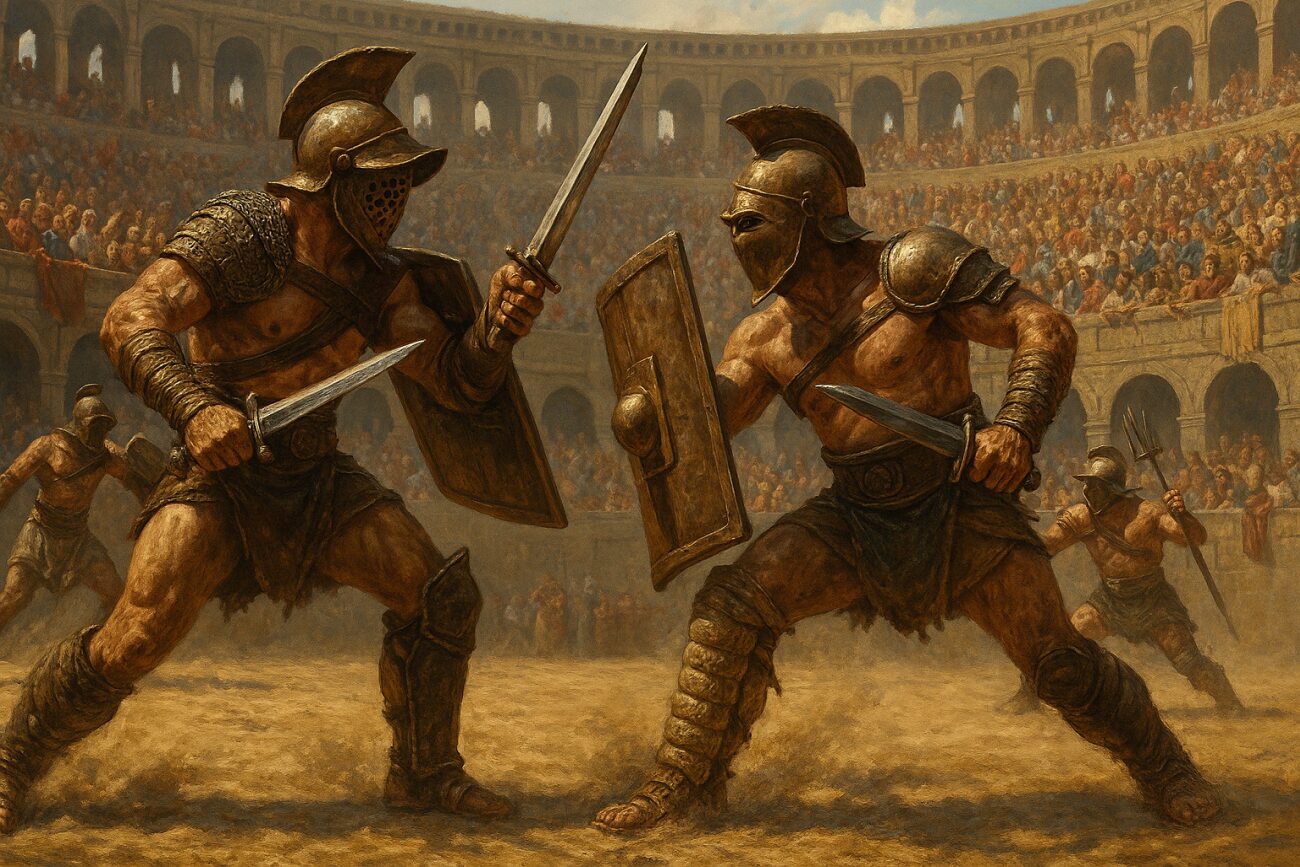In the dusty training grounds of ancient Rome, a young recruit stands nervously, clutching a wooden sword. The daily routine of a Roman gladiator was far from glamorous. It was a grueling path between survival and certain death. Gladiatorial games, which originated in 264 BCE, transformed ordinary men into extraordinary warriors destined to fight for the entertainment of thousands.
These fighters weren’t heroes by choice. Most were slaves, criminals, or desperate volunteers seeking a slim chance at freedom or glory in the Roman arena. The brutal world of gladiatorial training stripped away individual identity. It replaced it with a raw determination to survive against impossible odds.
The statistics were grim. By the end of the Roman Republic, gladiatorial games consumed an astonishing 67 days each year. For most participants, these games represented their final performance. It was a last desperate battle where survival was never guaranteed.
Key Takeaways
- Gladiatorial games began in 264 BCE as a form of public entertainment
- Most gladiators were slaves or volunteers with minimal rights
- Survival rates in the arena were extremely low
- Gladiators underwent intense physical and mental training
- Fighting was both a performance and a fight for survival
- Only a tiny fraction of gladiators achieved fame
Rigorous Training Regimens
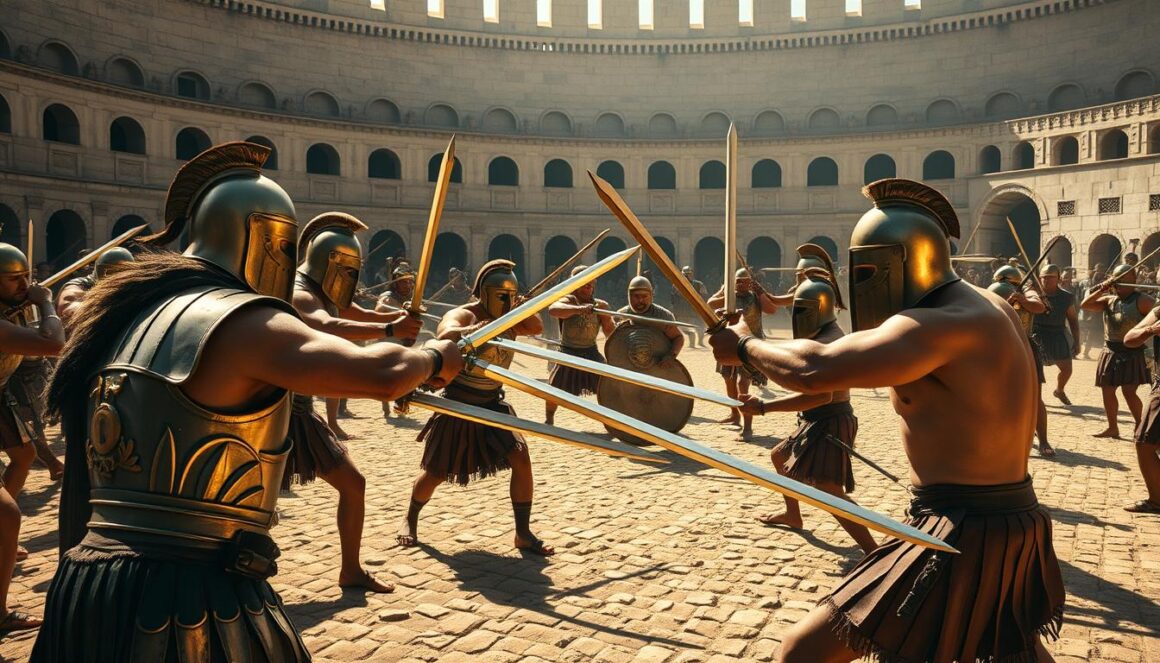
Gladiator training was a rigorous, systematic process that transformed ordinary men into formidable warriors. It started in specialized schools called Ludus Gladiatorius. There, recruits learned combat with wooden swords called rudis. These lightweight weapons allowed for practice without serious injury.
The training followed a unique four-day cycle, known as the Tetrad workout plan. Each day focused on different aspects of physical and combat preparation. Day one involved short, explosive movements. Day two included heavy compound exercises to build strength. Day three was for recovery, and day four focused on refining fighting techniques.
Gladiator weapons training was detailed and thorough. Trainees learned various fighting styles, mastering techniques like horizontal stabs and powerful chopping movements. They practiced with different weapons, understanding the skills needed for different scenarios. Physical conditioning was also emphasized, with stone dumbbells called halteraes used to build strength.
Gladiator armor was a critical part of their training. Trainees learned to move while wearing heavy gear, which could weigh up to 40 pounds. They developed incredible neck and shoulder strength to support their equipment. Some gladiators’ neck muscles were four times larger than average.
The training was extremely challenging, with sessions lasting up to five hours daily. Only the most dedicated and physically capable survived. Historical records show that less than 30% of gladiators ever gained their freedom, highlighting the extreme challenges of this profession.
The Gladiator Diet
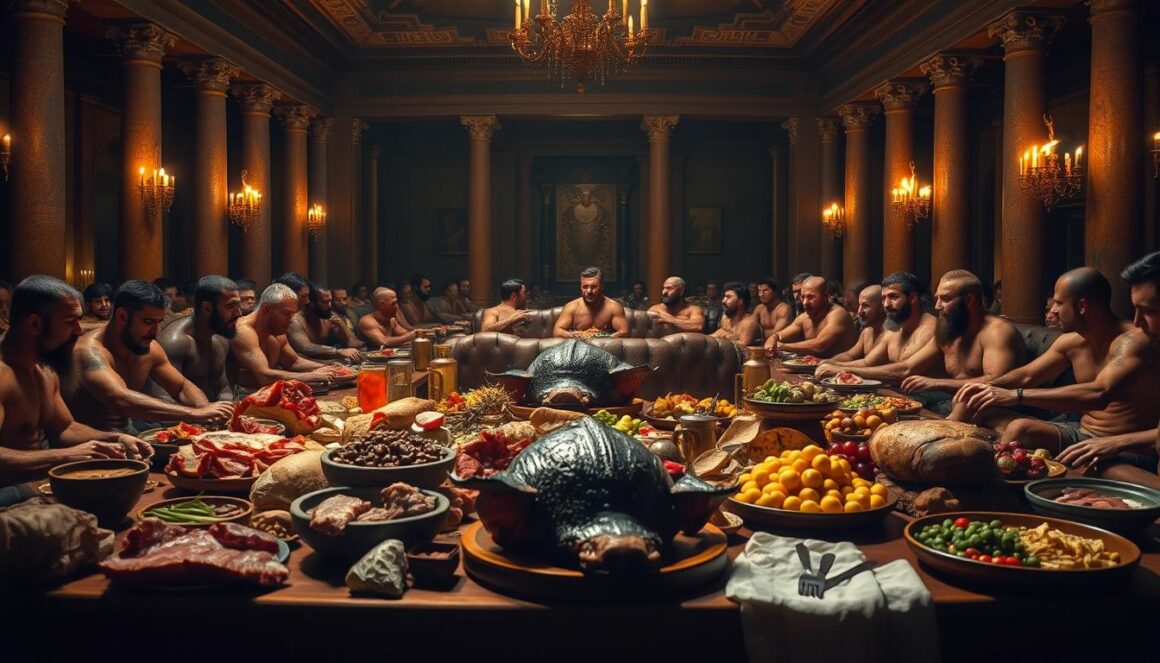
In ancient Rome, the gladiatorial combat required a specific nutritional approach. Known as “hordearii” or “barley men,” gladiators followed a diet rich in carbohydrates. This diet was essential for their intense physical demands in the Roman arena.
Their diet was heavily focused on carbohydrates, making up 70-80% of their nutrition. Barley, wheat, and legumes were staples in their meals. This high-carb diet aimed to create a protective layer of fat around vital organs during combat.
Nutritional research from ancient burial sites in Ephesus, Turkey, offers insights into their diet. Gladiators took calcium supplements made from charred plants or bone ash. These supplements helped strengthen their bones and aid in recovery. Unlike today’s fitness ideals, gladiators were not ultra-lean but had a robust physique for survival.
Dried fruits and beans were part of their grain-heavy diet. Galen, a renowned Roman medic, noted these foods provided sustained energy and resilience. Their diet was largely vegetarian, focusing on plant proteins and complex carbs for energy during long training and battles.
This diet transformed gladiators into powerful athletes, ready to face the extreme challenges of ancient Rome’s brutal entertainment.
Life in the Ludus (Training School)
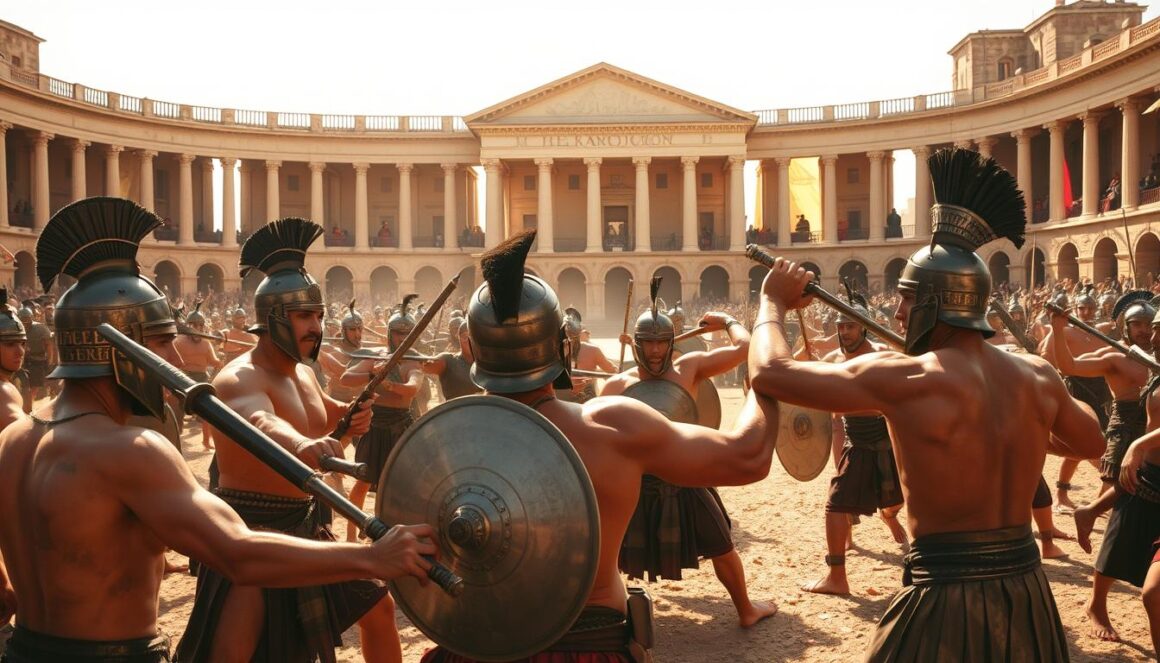
The ludus gladiatorium was no place for glamour. Gladiators endured cramped, harsh conditions that pushed their physical and mental limits. In small cells, multiple fighters competed, where survival was the only goal.
Gladiators’ days started before dawn. They began with intense physical training, honing their skills with wooden weapons. Their lifestyle demanded strict discipline. Trainers used psychological tactics and physical punishment to mold them into battle-ready warriors.
Gladiators were sorted into strict ranks, from Tirones (newcomers) to Retiarius fighters. Each group specialized in specific fighting styles and weapons. Their training aimed to build strength, stamina, and combat prowess for arena survival.
The social dynamics in the ludus were complex. Some were slaves or prisoners, while others chose this path for freedom or fortune. Even minor transgressions could lead to severe punishment or death, highlighting the arena’s brutal nature.
Yet, successful gladiators could gain fame. The ludus was both a training facility and a business venture. Lanistae invested heavily in transforming recruits into champions, aiming for profit and glory.
The Brutal Reality of Combat
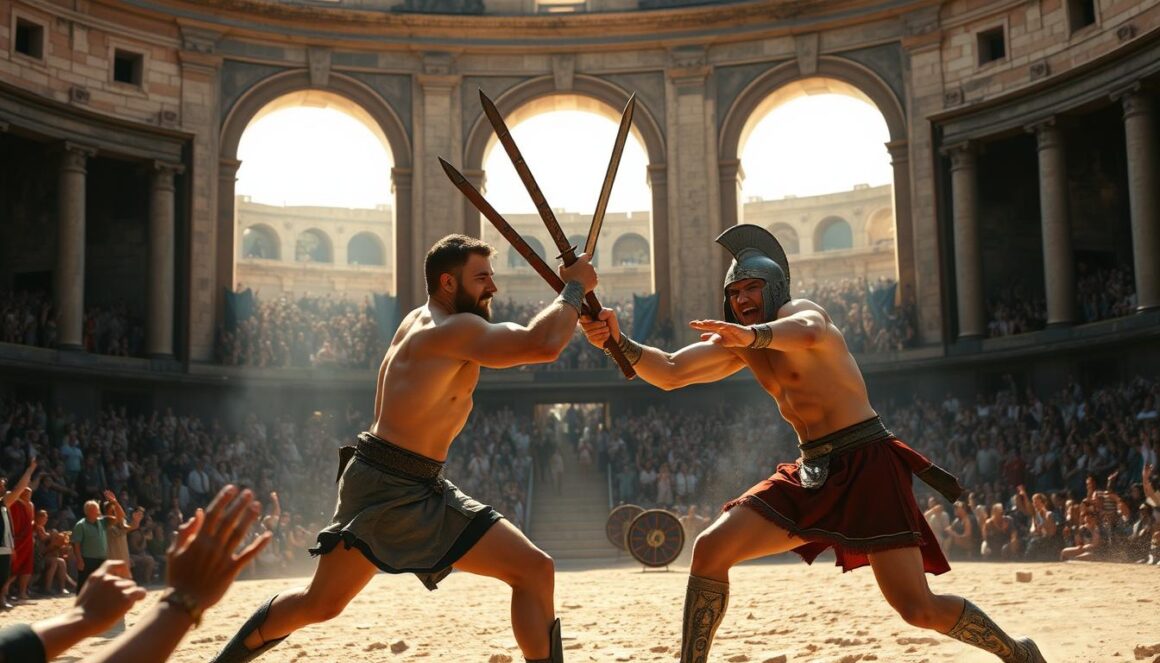
Gladiator fights in the Roman arena were far more complex than simple battles to the death. Contrary to popular belief, not every match ended in fatality. Historical records suggest that approximately 10% to 20% of gladiatorial bouts resulted in a fighter’s death, which was a terrifyingly high risk for participants.
Gladiatorial training prepared fighters for intense combat scenarios. Most gladiators were young men who faced extraordinary challenges. By their mid-20s, many had already experienced multiple life-threatening encounters. The average gladiator’s career was brutally short, with statistics indicating that only one in five survived long enough to potentially retire.
Different fighting styles and matchups created dramatic spectacles for Roman audiences. Fighters were strategically paired to showcase contrasting skills – lightweight warriors against heavily armored opponents. These carefully orchestrated battles weren’t just about survival but entertainment. The Roman arena demanded both technical skill and raw courage from its combatants.
Despite the deadly nature of their profession, gladiators weren’t always expected to fight to the death. Referees and event organizers often intervened, allowing defeated fighters a chance to survive. Crowd reactions and the presiding official’s judgment could spare a warrior’s life, adding an element of unpredictability to each match.
The psychological and physical toll of gladiatorial combat was immense. Fighters knew each bout could be their last, creating an intense, high-stakes environment that pushed human endurance to its absolute limits.
Injuries and Medical Care

The daily life of a Roman gladiator was filled with medical challenges. Galen of Pergamon, a renowned physician, treated gladiators from 158 to 161 CE. He developed medical care for these warriors, claiming to save nearly all fighters under his care.
Gladiatorial training posed extreme physical risks. Archaeological findings in Ephesus show a wide range of traumatic head injuries. Some wounds healed, while others were fatal. The injuries came from helmet blows, sword strikes, and trident punctures, highlighting the brutal combat.
Roman medical practices were unique for gladiator health. Physicians aimed to balance four bodily humors and used innovative treatments. Interestingly, gladiators received better medical care than average citizens. They enjoyed massages, hot and cold baths, and lived in conditions to prevent disease.
The medical understanding of injuries was limited by Roman laws against human dissections. Physicians like Galen relied on animal studies to understand human anatomy. Despite these limitations, they developed advanced treatment methods that influenced medical practice for centuries.
Remarkably, gladiator blood was seen as a potent medical remedy. Roman doctors believed it could cure epilepsy. Spectators even collected pieces of a slain gladiator’s liver, believing in its healing properties. This practice shows the complex medical beliefs of ancient Roman society.
The Role of Fame and Fortune
In ancient Rome, gladiators became unexpected celebrities. These warriors, known for their bravery in the arena, captured the hearts of thousands. Their lives were not just about combat; they offered a path to fame and fortune.
Top gladiators earned significant prize money and social status. They were the rock stars of their era, attracting fans and gaining public admiration. Some even secured endorsement deals, using their fame to promote products.
The most renowned gladiators could win their freedom through exceptional performances. Their success was more than just survival; it was a symbol of hope and change in a strict society. Wealthy patrons sponsored promising fighters, seeing both entertainment and financial benefits.
Yet, the journey to fame was fraught with danger. Most gladiators never reached stardom, with many dying in their early fights. This contrast between glory and reality defined their complex lives.
By the first century, free men lined up to fight in gladiatorial contests, seeking fame and social advancement. This showed the strong appeal of a gladiator’s legacy in Roman society.
The Inevitable Fate of Gladiators
The daily life of a Roman gladiator was perilous. Survival was a long shot for most. Dreams of freedom were common, but few lived long enough to see it.
Training for combat was grueling and often deadly. While death was not as frequent as thought, the danger was always present. The editor and the audience’s decisions were key to a gladiator’s fate. A fighter could be spared by falling to his knees and raising an index finger.
Surviving in the gladiator world required strategic thinking. Some fighters earned freedom after years of service. About half were volunteers. Those who made it might find work in security or start small businesses, but such chances were scarce.
Audience reactions greatly influenced a gladiator’s survival. Shouts like “Habet, Hoc habet!” or “Mitte!” could change a fighter’s fate. The “thumb signal” – up or down – was a critical moment in deciding life or death.
In the end, most gladiators had short, brutal lives. The games lasted nearly a thousand years, but fighters rarely survived more than a few battles. Their legacy was one of bravery, skill, and the constant threat of death.
Famous Gladiators
The Roman arena was a stage for incredible warriors, turning them into legendary figures in ancient Rome’s entertainment. Spartacus, a name that echoes through history, was the most renowned gladiator. He began as an enslaved fighter but led a massive rebellion of 100,000 enslaved people against the Roman Empire during the Third Servile War.
Spiculus also made a name for himself, becoming a favorite of Emperor Nero. He was rewarded with palaces and gold, a rare honor for those in the Roman arena. His victories, including defeating Aptonetus, who had 16 wins, solidified his fame.
Emperors like Commodus took their fascination with gladiatorial combat to extreme levels. He fought in the arena 735 times, mixing imperial power with entertainment. Flamma, another extraordinary gladiator, turned down freedom multiple times and completed 21 matches with only 4 losses.
The battle between Priscus and Verus became a legendary event in ancient Rome’s entertainment. Their epic fight in the Flavian Amphitheatre lasted hours, ending in a draw. Emperor Titus awarded both fighters their freedom, showing the respect gladiators commanded.
These warriors were more than fighters; they were celebrities, sex symbols, and cultural icons. They captured Roman society’s imagination with their extraordinary skills and remarkable survival stories in the brutal world of gladiator fights.
Wrapping Up: The daily routine of a Roman gladiator
The daily life of a Roman gladiator was far more complex than popular culture suggests. From sunrise to sunset, these warriors lived a structured existence within the ludus. They were dedicated to training, survival, and entertainment in ancient Rome. Their lifestyle was a grueling mix of intense physical preparation, strict dietary regimens, and constant risk of death in the arena.
Gladiatorial combat was more than just a spectacle. It was a reflection of Roman social dynamics, where life and death were determined by crowd approval. Despite the high mortality rates, with professional gladiators facing a one in ten chance of death during a bout, many saw this path as their only chance for fame and freedom. The wooden sword (rudis) symbolized the ultimate dream: survival and eventual retirement from the brutal arena.
By 404 CE, Emperor Honorius banned gladiatorial games, ending centuries of this extraordinary lifestyle. Modern perceptions often romanticize these fighters, but historical evidence shows a stark reality. It reveals systematic training, nutritional strategies, and extraordinary physical endurance. The legacy of Roman gladiators continues to captivate our imagination, reminding us of a civilization where human resilience was tested in its most extreme form.
The story of Roman gladiators goes beyond mere entertainment. It reflects human courage, societal structures, and the profound human capacity to survive under unimaginable circumstances. Their daily routine was a testament to human determination in the face of overwhelming odds.
FAQ
Were all gladiators slaves?
Not all gladiators were slaves. Many were enslaved, forced into combat. Yet, some were voluntary fighters seeking fame and fortune. Prisoners of war, criminals, and even free citizens chose this path for social and economic gains.
How long did a typical gladiator’s career last?
Gladiators’ careers were brief, lasting only 3-5 years after training. The harsh combat and physical demands were too much for most. Few survived long enough to gain freedom or retire.
What did gladiators eat to stay strong?
Gladiators ate a diet high in carbohydrates, including barley and beans. This diet gave them protective fat, earning them the name “hordearii” (barley eaters). It provided energy and helped protect against cuts and wounds.
Did gladiators always fight to the death?
No, not all fights were fatal. Referees and editors often controlled the combat. Many matches ended with surrender or mercy, benefiting skilled and popular fighters.
Could gladiators earn their freedom?
Yes, gladiators could earn freedom through exceptional performance. Winning fights, showing skill, or gaining public favor could lead to manumission. This was rare, though.
What weapons did gladiators typically use?
Gladiators used specialized weapons based on their fighting class. They wielded short swords (gladius), tridents, nets, daggers, and shields. Each type of weapon matched a specific fighting style and armor.
How were injured gladiators treated?
Injured gladiators received care from trained physicians. They used herbal remedies, surgery, and rehabilitation to get them back in the arena.
Were there different types of gladiators?
Yes, there were various gladiator classes. Each had unique equipment and fighting styles. Examples include the Thraex, Murmillo, Retiarius, and Secutor, each with specific armor and weapons.
How did people become gladiators?
People became gladiators through different paths. Some were military prisoners, slaves, or convicted criminals. Others were volunteers seeking fame or economic improvement.
What was life like in a gladiator training school?
Life in a ludus was strict and disciplined. Gladiators lived in barracks, trained daily, followed strict diets, and were supervised by trainers and managers called lanistas.

